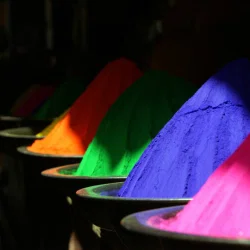Here are key features and aspects of fluorescent pigments
2023-12-12
Fluorescent pigments are a type of colorant that emits visible light when exposed to ultraviolet (UV) light. These pigments are known for their vibrant and intense colors, and they are widely used in various applications to create eye-catching and high-visibility effects. Here are key features and aspects of fluorescent pigments:
1. Fluorescence Mechanism:
- Fluorescent pigments exhibit fluorescence, a process in which absorbed light energy is re-emitted as visible light. When exposed to UV light, the pigments absorb the energy and then emit light in a different color, creating a vivid and luminous effect.
2. UV Light Source:
- The fluorescence of these pigments is most apparent under UV light, which is not visible to the human eye. Common sources of UV light include blacklights or other UV lamps.
3. Intense Colors:
- Fluorescent pigments are known for producing highly saturated and intense colors. These colors often include shades of neon or fluorescent yellow, green, orange, pink, and red.
4. Applications in Printing Inks:
- Fluorescent pigments are frequently used in the printing industry for creating eye-catching graphics and designs in various printed materials, such as posters, packaging, labels, and textiles.
5. Textiles and Clothing:
- Fluorescent pigments are utilized in the textile and clothing industry to produce brightly colored fabrics and garments. They are often seen in sportswear, activewear, and safety apparel for enhanced visibility.
6. Safety and Warning Signs:
- Due to their high visibility, fluorescent pigments are commonly employed in safety signs, road markings, and warning labels. The intense colors make these signs more noticeable, especially in low-light conditions.
7. Plastics and Coatings:
- Fluorescent pigments are used in the production of plastics and coatings to achieve vibrant and attention-grabbing finishes. These materials are commonly used in toys, consumer goods, and industrial products.
8. Art and Craft Supplies:
- Fluorescent pigments are popular in the realm of arts and crafts. Artists use fluorescent paints, inks, and pigments to create bold and luminous effects in paintings, drawings, and various craft projects.
9. Cosmetics and Body Paint:
- Fluorescent pigments are employed in cosmetics and body paints to create striking and unconventional makeup looks. Neon and fluorescent colors are often used in makeup for special events, festivals, and performances.
10. Security Features:
- Fluorescent pigments are sometimes used as security features in documents, such as banknotes and passports, to deter counterfeiting. The unique fluorescence properties can be difficult to replicate.
11. Decorative Lighting:
- Fluorescent pigments are used in the creation of decorative lighting products, including fluorescent lamps and tubes. These products emit colored light when illuminated with UV light.
12. Educational Materials:
- Fluorescent pigments are used in educational materials, such as highlighters and markers, to emphasize important information on documents and study materials.
13. Novelty and Entertainment Products:
- Fluorescent pigments are often incorporated into novelty items, toys, and entertainment products, creating visually stimulating effects in various consumer goods.
It's important to note that while fluorescent pigments can provide vibrant colors and high visibility, their longevity and resistance to fading can vary depending on factors such as exposure to UV light, environmental conditions, and the specific application. Proper formulation and protection measures are often employed to enhance their performance and durability in different products.



